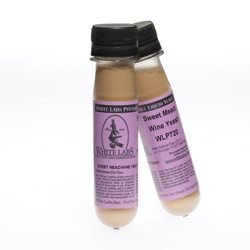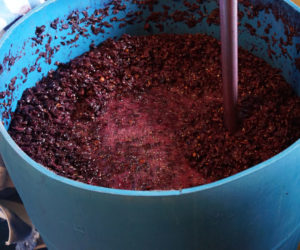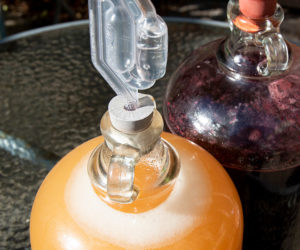 When most people think of a great wine and what sets it apart from other wines, they typically look to the usual suspects: grape variety and quality, composition of the grape must, viticulture (soil, water management, vine canopy, ripeness), and vinification (grape crushing, must treatment, skin contact). Very few would even consider the art of fermentation as an important part of winemaking. However, as many professional and hobby brewers know, the yeast fermentation plays a critical role in producing unique flavor and aroma compounds in both beer and wine.
When most people think of a great wine and what sets it apart from other wines, they typically look to the usual suspects: grape variety and quality, composition of the grape must, viticulture (soil, water management, vine canopy, ripeness), and vinification (grape crushing, must treatment, skin contact). Very few would even consider the art of fermentation as an important part of winemaking. However, as many professional and hobby brewers know, the yeast fermentation plays a critical role in producing unique flavor and aroma compounds in both beer and wine.
In wine, the role of yeast is underestimated. The minor metabolites produced by yeast during fermentation are crucial to the sensory profile of any wine. Because yeast is a live, active component of fermentation, many shy away from learning much about it. Yeast can be complicated and fickle, and can sometimes cause a great deal of head-scratching when they don’t perform as expected. Nonetheless, being well-versed yeast biology is one of the most important weapons in a vintners arsenal.
Yeast in Winemaking
Although winemaking is an age-old practice, little was known of the existence of yeast. Ancient cultures believed that turning grape juice into wine was a mysterious feat of the gods. For centuries this belief was carried on until the famous scientist, Louis Pasteur, discovered the microorganisms in 1866. Decades later, Emil Hansen of the Carlsberg Laboratory in Denmark, isolated the first strains of yeast and began banking them. Since the dawn of the modern age, we have benefited from the use of isolated commercial yeast cultures. Aside from ethanol production, yeast strains have been selected for many hundreds of years for a variety of characteristics they display during fermentation.
Biology of Yeast
Yeast are a fungus, and the species used in winemaking are of the genus Saccharomyces (typically S. cerevisiae or S. bayanus), just two of over 1,500 species of yeast. There are numerous strains of S. cerevisiae or S. bayanus used by winemakers. Yeast are single-celled organisms that ferment sugars in the grape must to produce ethanol and carbon dioxide. As secondary byproducts to this metabolic process, the yeast also produce flavor-active and aroma-active compounds. The types and quantities of these compounds produced vary by strain. Some strains produce high levels of ester compounds, resulting in such aromas as pear, apple, and banana, while other strains produce high levels of phenolics which can result in spicy characteristics in wine. Most of the aroma characteristics described in the Wine Aroma Wheel are yeast-derived compounds, both directly and as a result of chemical reactions with other wine components.
Saccharomyces can be metabolically active in both the aerobic and anaerobic state. (Aerobic means in the presence of oxygen and anaerobic means in the absence of oxygen.) During fermentation, the yeast cell undergoes many biological processes that can affect the outcome of a wine. The yeast begins in what is called the lag phase, when each cell can assess its environment and acclimate itself to current conditions. The cell senses the amounts of sugars and nutrients present in the must and signals the activation of several enzymes that will later help to breakdown saccharides and proteins into smaller, usable components. This is followed by the log phase where lipid and protein production are encouraged for cell growth. The cell then enters glycolysis (a series of reactions), where glucose is used to produce ethanol and CO2 in the absence of oxygen. The stationary phase begins when there are few fermentable sugars left. During this phase, yeast populations remain constant, alcohol levels begin to inhibit yeast performance and cells begin to drop.
Dried Yeast
Today yeast is available in both dried and liquid forms, with each having its own set of pros and cons. Traditionally, yeast was prepared for winemaking by creating a liquid starter inoculum, but this became tedious due to the labor-intensive step-up procedures for propagation. This practice died out in the late 1960s when Red Star developed the first strains of dried yeast in 1965. Because of its ease of use and accessibility, the use of dried yeast for winemaking became the status quo. Dried yeast is readily available and has a shelf life of at least two years when stored under 50 °F (10 °C), and is often less expensive than liquid cultures. However, dried yeast is limited in variety, as some strains of yeast do not hold up to the drying process well. The stress of this, along with the necessity of rehydration, can lead to yeast cells that are less viable resulting in a loss of metabolic activity.
Liquid Yeast
On the other hand, liquid yeast is offered in a wide variety of strains that are already live. These cultures are also completely pure and free from any kind of contaminants. Although liquid cultures require a longer lead time, as they have to be grown on demand, many strains have become readily available to both professional and home vintners. (See the chart on page 28 for a full list of liquid strains.) The yeast is ready to immediately inoculate must and requires no rehydration. These cells are more metabolically active, and grow significantly during the course of fermentation. There are two companies that supply liquid yeast to home winemakers, White Labs (of San Diego, California) and Wyeast Laboratories (of Odell, Oregon).
Producing Liquid Yeast
Both companies produce liquid yeast in a similar manner. White Labs banks their yeast strains frozen in glycerol at -80 °C (-112 °F). Working cultures are grown on agar plates. Yeast samples are transferred from the plates to a liquid media and stepped up in volume over a couple weeks. The specific gravity of the culture media is low compared to wine must, and the media is continually aerated. The temperature, level of aeration and pH of the solutions are monitored and adjusted to favor rapid yeast growth.
White Labs performs a variety of tests on their yeasts including examining stained cells under a microscope for viability, plating cells on various differential media for the presence of contaminating bacteria and wild yeast and screening for mutation. Before packaging, yeast go through a “mini-starvation” stage in which the yeast cells quit budding off new cells and lay down a store of glycogen, which helps them survive the time between packaging and pitching.
At packaging, the yeast cells in both White Labs and Wyeast packages are 99% viable, compared to an average of about 85% viability for dried yeast. Both companies date their packages so home winemakers can assess their freshness. White Labs packages their yeast in tubes, while Wyeast packages theirs in “smack packs.”
The process for producing dried yeast is similar, with the obvious difference that a drying phase is added. Another difference is the size of the batches produced. Because of its longer shelf life, dried yeast is made less frequently and in much larger batch sizes than liquid yeast.
Your local homebrew shop should have its liquid yeast refrigerated and, if you order from a website, you should opt for cooling packs (if available) to keep the yeast cold during shipment. At home, store your liquid yeast in your refrigerator. If a liquid yeast package freezes, the yeast cells inside will rupture and die.
A single tube or pack of liquid yeast contains sufficient cells to inoculate 5.0 gallons (19 L) of wine must. Before adding the culture, remove it from the refrigerator and let the culture warm to within 10 °F (~5 °C) of your wine must. For larger volumes of wine, a starter culture can be made to raise more yeast. For example, to double the amount of yeast cells, dilute some fruit juice (grape, apple, pear, etc) with water that has been boiled and cooled to yield 1.0 gallon (3.8 L) of dilute juice at a concentration below 10 °Brix (SG 1.040). Do this in a clean, sanitized 1.0-gallon (3.8-L) jug. Add 1⁄2 teaspoon of complete yeast nutrients to the juice, cap the jug and shake vigorously for two minutes. Add the contents of the liquid yeast pack, affix a fermentation lock and let the yeast multiply — at 70–80 °F (21–27 °C) — for one or two days.
Yeast Nutrition
All yeasts, whether liquid or dried, have very specific nutritional requirements in order for them to function properly. Since fermented beverages can create a somewhat hostile setting for yeast, lack of adequate food can lead to incomplete and stuck fermentations. Much of this depends on the grapes themselves — grape variety and the availability of amino acids. However, adding nutrients to the must will help maintain a favorable environment for the yeast culture and ensure that it will perform optimally. Typically yeast cells require zinc at 0.1 mg/L, manganese at 0.2–0.3 mg/L, and calcium at 20–50 mg/L. These components contribute to the metabolism of amino acids that will eventually result in the building of healthy cell walls. Most importantly, yeast need the proper levels of nitrogen, usually between 140–200 mg/L for lipid metabolism. Armed with the building blocks for strong cell walls, yeast cells are then able to withstand the stresses of fermentation. Most commercially-available complete yeast nutrients provide adequate levels of these compounds.
Ethanol Production
One of the most important considerations when it comes to selecting a yeast strain is the alcohol production. The differences vary quite significantly between strains, although both S. cerevisiae and S. bayanus strains used in winemaking are very alcohol tolerant. For some wines, such as certain whites, it may be more suitable to use a strain that produces less alcohol, while some reds could benefit from higher levels of alcohol. Yeast manufacturers can provide alcohol tolerance levels for their specific strains.
Other Fermentation Byproducts
During the formation of ethanol and carbon dioxide, the yeast cell also produces the byproducts that make a major contribution to flavor and aroma. The primary aroma-active compounds of interest are n-propanol (alcoholic, harsh), iso-amyl alcohol (alcoholic, vinous), ethyl acetate (solvent, nail polish remover), iso-amyl acetate (fruity, banana), acetaldehyde (grassy, green apple), diacetyl (buttery, butterscotch), and sulfur compounds.
Aside from ethanol, yeast will also produce different levels of higher, or fusel, alcohols as a fermentation byproduct. The main alcohols that are produced are propanol, iso-amyl alcohol, and iso-butanol. The biosynthesis of amino acids from nitrogen (free amino nitrogen) is one of the largest contributors to the formation of these flavor-active compounds. The amino acids, leucine, isoleucine, and phenylalanine can be converted to higher alcohols, predominantly iso-amyl alcohol and n-propanol in wine. These alcohols contribute to the harsh alcoholic, vinous character and can be typical in many musts with high sugar concentrations. In large quantities, these compounds can be “hot” or solventy, and can mask wine aromas. Lesser quantities can actually improve a wine, adding complexity and mouthfeel. Reaction of these fusel alcohols with other metabolic intermediates (acids) result in the production of iso-amyl acetate, ethyl acetate, and other trace ester compounds. Ethyl acetate is the most common, producing a solvent or nail polish remover quality in large amounts. Iso-amyl acetate, when present and detectable, is the larger flavor contributor, giving wine pronounced fruitiness even in small quantities.
Other common byproducts are the carbonyls – diacetyl and acetaldehyde. Diacetyl is always produced as an intermediate in amino acid synthesis. The compound’s precursors leave the yeast cell, form diacetyl and are taken up again by the cell and reduced to a flavorless compound. Acetaldehyde is commonly produced by most strains as well, but typically in lower quantities. It is a very volatile substance, and in small quantities will disappear over time, but creates an apple or nutty character. It also enhances color development in red wines by promoting condensation reactions to form stable molecules that contribute to color.
Some less detectable flavor compounds are phenolics — vinyl phenols, guaiacol, and eugenol. These typically display spicy, peppery characteristics in wine. Additionally, sulfur compounds are produced by yeast during fermentation. The most common sulfur compound is hydrogen sulfide (H2S), which is usually an undesirable component in any beverage. It is detectable by the average person at a very low level and is usually described as rotten eggs. However, H2S reacts with organic (amino acids) and inorganic (outside sources of nitrogen) compounds to form mercaptans. Yeast causes amplification of the compounds found in grapes to form these mercaptans, which contribute passion fruit, guava, or grapefruit characteristics in wine. Another common group of sulfur compounds are the thiols. Furfurythiol, in particular, is produced when the yeast transforms furfural found in toasted oak staves and generates roasted coffee or bready flavors and aromas.
Wine Styles
All wine styles can benefit from the use of liquid yeast. In brewing, liquid yeast is known to be one of the biggest players in creating beer flavor and aroma. Traditionally yeast has only been considered a major factor in flavor contribution with aromatic white and fruit-forward wines. It is true that yeast flavor-active compounds do improve the fruity character in these wines. Yeast cells will also react with a wide array of compounds present in all grape musts to create an even bigger array of flavors and aromas, enhancing grape varietals. They contribute to wine character in young wines by producing countless aroma compounds including butterscotch, caramel, nutty, woody, apple, pineapple, banana, guava, passion fruit, spicy, and clovey. With aged wines, the rule of thumb should be to start with the best possible product before aging. With these wines, complexity comes from reactions that continue to occur between the secondary yeast metabolites and grape-derived compounds.
With the diversity of liquid yeast strains on the market, you can really create a unique product. Different strains of yeast will create a variety of different flavor and aroma profiles. Varying fermentation conditions such as pH, sugar levels, and fermentation temperature will further affect the intensity and quality of the flavor-active compounds produced by any strain. In this way, each winemaker can develop specific flavor profiles for their own wine. Liquid yeast can help you run successful, consistent, microbe-free fermentations. But the biggest and most significant message here: understand what is happening in your fermentation. Armed with this information, you can create that exceptional wine that will be complex and unique.






